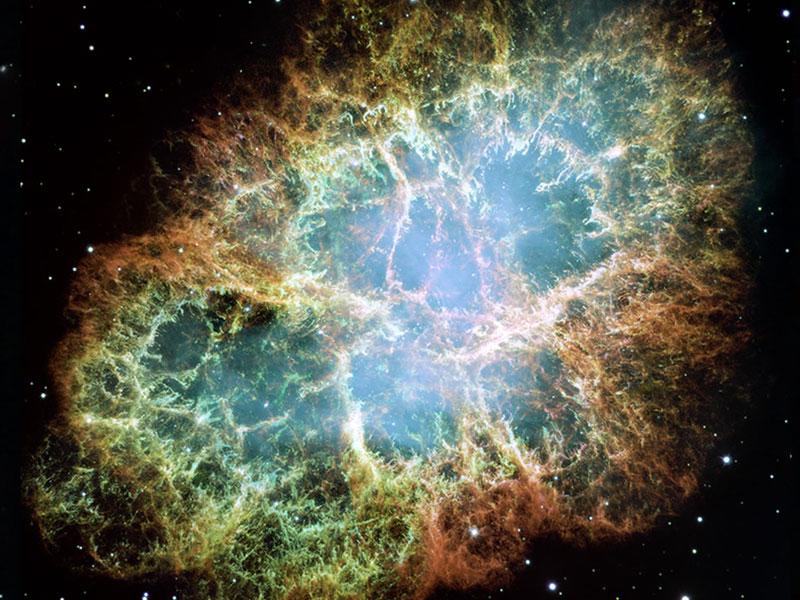Ka-boom
At the recent American Astronomical Society meeting in Washington D.C., astronomers Peter Garnavich of the University of Notre Dame and Alex Filippenko of the University of California at Berkley described a whopping stellar explosion called Y-155. It started out as a Humpty Dumpty of a star, about …
At the recent American Astronomical Society meeting in Washington D.C., astronomers Peter Garnavich of the University of Notre Dame and Alex Filippenko of the University of California at Berkley described a whopping stellar explosion called Y-155. It started out as a Humpty Dumpty of a star, about 200 times the mass of the Sun. It became so hot at its core that it may have begun to produce matter/antimatter particle pairs, causing an instability that led to a runaway thermonuclear reaction and an explosion about ten times as bright as a Type Ia supernova, the next most powerful explosion known.
Stars more massive than eight of our suns typically end their lives in a supernova, like the one that created the Crab Nebula in 1054. Really big stars, however, between 150 and 300 solar masses, appear to advance to this next stage of antimatter-triggered destruction that scientists had theorized about for decades, and are now observing beginning with the best candidate, discovered in 2007. Luckily for us, Y-155 blew up halfway across the visible universe, about seven billion years ago.

In his 2008 book Death From the Skies, astronomer Phil Plait considered how big a stellar explosion would have to be, and how close, to end life on Earth. A Type Ia supernova would need to go off within about 25 light years of us, according to Plait, Filippenko, and Garnavich, to torch the ozone layer enough to disrupt the food chain. There are no stars this close to us on the verge of exploding. Plait offers an appendix of 24 stars within a thousand light years that will one day blow, but at that distance they won't become much more than very bright. Eta Carinae, 7,500 light years away, will be a beauty, at a very safe distance, and apparently not big enough for an antimatter trigger. But if humans and books are still around then, we'll be able to read the books at night by Eta Carinae's light.
As for Y-155, it was more powerful than Eta Carinae would be, releasing at the peak of its explosion about 100 billion times the Sun's energy output. "If Y-155 had exploded in the Milky Way, it would have knocked our socks off," said Garnavich in his press release. What does that mean? He replied by email: "Whatever a Type Ia supernova could do, Y-155 could do it ten times better at the same distance." Or, it could cause the same amount of destruction from three times farther out, as its energy falls off with the square-root of its distance. So if such a supernova occurred out to 75 light years, we'd be in serious trouble.
Fortunately, the chance of that happening these days is very low. Y-155 dates from an era when such huge stars are thought to have been more common due to the early Universe's more pristine state—it had not yet been polluted by generations of supernovae, which create elements heavier than hydrogen and helium that appear to keep stars from getting so big.
Nice to be living in the modern era.
Stars more massive than eight of our suns typically end their lives in a supernova, like the one that created the Crab Nebula in 1054. Really big stars, however, between 150 and 300 solar masses, appear to advance to this next stage of antimatter-triggered destruction that scientists had theorized about for decades, and are now observing beginning with the best candidate, discovered in 2007. Luckily for us, Y-155 blew up halfway across the visible universe, about seven billion years ago.

In his 2008 book Death From the Skies, astronomer Phil Plait considered how big a stellar explosion would have to be, and how close, to end life on Earth. A Type Ia supernova would need to go off within about 25 light years of us, according to Plait, Filippenko, and Garnavich, to torch the ozone layer enough to disrupt the food chain. There are no stars this close to us on the verge of exploding. Plait offers an appendix of 24 stars within a thousand light years that will one day blow, but at that distance they won't become much more than very bright. Eta Carinae, 7,500 light years away, will be a beauty, at a very safe distance, and apparently not big enough for an antimatter trigger. But if humans and books are still around then, we'll be able to read the books at night by Eta Carinae's light.
As for Y-155, it was more powerful than Eta Carinae would be, releasing at the peak of its explosion about 100 billion times the Sun's energy output. "If Y-155 had exploded in the Milky Way, it would have knocked our socks off," said Garnavich in his press release. What does that mean? He replied by email: "Whatever a Type Ia supernova could do, Y-155 could do it ten times better at the same distance." Or, it could cause the same amount of destruction from three times farther out, as its energy falls off with the square-root of its distance. So if such a supernova occurred out to 75 light years, we'd be in serious trouble.
Fortunately, the chance of that happening these days is very low. Y-155 dates from an era when such huge stars are thought to have been more common due to the early Universe's more pristine state—it had not yet been polluted by generations of supernovae, which create elements heavier than hydrogen and helium that appear to keep stars from getting so big.
Nice to be living in the modern era.